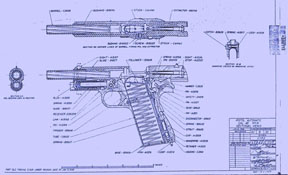Recoil operation is the name for a particular type of mechanical action in a self-loading firearm. It may be found in semi-automatic or automatic weapons. In general, weapons of this type utilize the conservation of momentum to harness the rearward impulse from firing - the recoil - to extract and eject the empty cartrdige and then chamber the next round to ready the gun to fire again.
This type of action is divided into long recoil and short recoil types.
The long recoil action is one where the barrel and bolt or slide of the firearm remain locked together as they recoil, all the way to the rear-most position of the mecahnism. They are then unlocked, and the barrel, under the influence of the recoil spring, returns forard first while the bolt remains locked to the rear and the extractor hooks to the cartridge. The barrel (and chamber) moving forward extracts the cartridge from the chamber. Once the barrel has returned forward, the bolt is unlocked and chambers the next available round.
In a short recoil action, the barrel and bolt travel together only a short distance; this travel is used to operate a the chamber locking/unlocking system rather than to fully extract the cartridge. At the end of the joined movement, they are unlocked and the barrel is stopped. The bolt (and cartridge in the chamber) continue to move rearward, extracting the empty cartridge and then chambering the next.
The long recoil system is mostly used in long guns, where there is more room for the system to operate behind the firing mechanism. John Moses Browning's famous Auto 5 semi automatic shotgun is a long recoil system. Very few handguns use long recoil, as the user's hand placement makes a long reciprocating action impractical. There have been some, however; the Frommer Stop, a Hungarian pistol from 1912, uses a long recoil design. Even earlier, a design known as the Roth-Theodorovic pistol was proposed for military contracts in Austria in the 1890s. Although it was never adopted or sold commercially, elements of its design went into the more successful Roth-Steyr 1907 handgun (a short recoil action).
Modern semi-automatic handguns generally use short recoil actions, with barrel and slide locking and unlocking by a variety of methods ranging from the 1911's tilting barrel freeing its locking lugs to the famous toggle lock of the Luger and the roller locked Heckler & Koch P9S or Korth PRS. In these guns, the barrel moves only a short distance, with the mechanism then unlocking the chamber and permitting the bolt and/or slide to continue rearward.
Recoil operation is generally more robust and requires less maintenance than a gas-operated system, and in addition the recoiling component can absorb some of the gun's recoil making it easier to fire for the user. However, to operate correctly, the gun generally must produce a recoil impulse within the design range of the firearm - meaning that in order to use ammunition that is more or less powerful than the design loads by enough of a difference, the action of the gun must be adjusted (springs can generally be changed).
Inertia operation is closely related to recoil operation. In the former, however, rather than the rearward motion of a component of the firearm under recoil operating the mechanism, the entire gun recoils and an isolated component remains still due to inertia; that component is used to unlock/operate the firearm.
